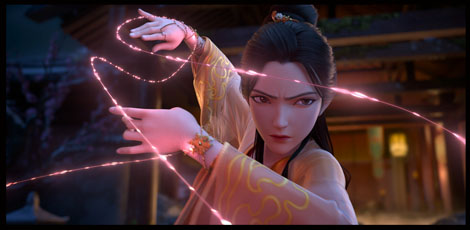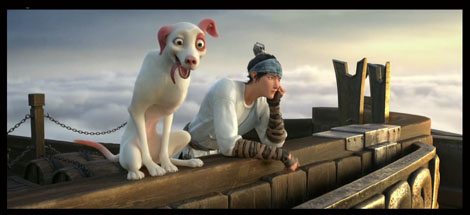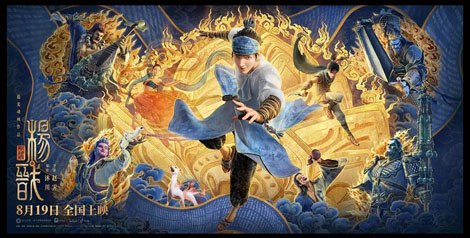
Yang Jian is the second feature in the New Gods series, a continuation of Nezha Reborn, both directed by Zhao Ji. It is not necessary to see the first feature to appreciate Yang Jian, but those who wish to can dial it up on Netflix to gain a bit of depth. The New Gods series is an invigorating dip into Chinese mythology, retold with cutting-edge animation technology and a heavy tendency toward VFX-enhanced action scenes (of which there are many).
For this review, I will go light on the story and plot, which I find to be somewhat of a hindrance when balanced against the outstanding character development and irresistible visual treats provided by the animation. The film is overstuffed with characters, and unless the viewer pays close attention to the unfolding story, they may need a scorecard. Some characters seem minor, then reappear later in essential roles. Others disappear and then reappear in different locales as the script demands. Yet other characters are introduced so late in the story that the script becomes overwhelming. One certainty: There are a lot of them. A Ph.D. in Chinese mythology is not needed to enjoy the film. Still, a passing familiarity with its themes would be helpful, especially when trying to place what roles certain characters ultimately play in the story.

The tale concerns a once-powerful god of war (Yang Jian), who, due to certain events thirteen years prior (sorry, no spoilers!), has been reduced to an impoverished bounty hunter who can barely afford cosmic gas for his steampunk-inspired ship. When a beautiful dancer (Wanluo) offers Jian a job, he accepts the challenge of locating and returning to Wanluo, a Magic Lotus Lantern of inestimable power. This brings Jian into a deadly conflict with the murderous young criminal Chenxiang, Jian’s long-lost nephew, who is pursuing the Lantern for reasons of his own. So are at least four other groups of mercenaries, each with their reasons for wanting the film’s elusive McGuffin. Twist, turns, betrayals, and surprises ensue as Jian battles his way through not only rivals for the Lantern but also dark family secrets that make the generational conflicts in Strange World look like arguments over a lollipop.
If one is not paying attention to every nuance of the story, it is likely because it is impossible to take one’s eyes off the stunning animation. In just a single viewing, one can see 2D, 2.5D, 3D, motion-capture, FPS cuts, and in one scene where the protagonist is imprisoned in a magic scroll, what appears to be enhanced rotoscoping in the style of Richard Linklater’s Waking Life (2002). Yang Jian is a cornucopia of animation techniques set against backgrounds and layouts of marvelous complexity. For example, the opening scene is set on Penglai Fairy Island: Imagine Blade Runner in 3D animation, taking place on four different camera levels, each in constant motion.

Several notable set pieces include a multilevel chase on Penglai, a prison breakout involving escape from an eight-headed dragon god, and Wanluo’s exquisite zero-gravity dance sequence that recalls a slow-motion Busby Berkley number. One of my favorite VFX moments involved a demon villain whose riffs on a Chinese banjo produce lethal blades instead of musical notes. There are nods to other films; Blade Runner is the most obvious, but visual homages to Avatar and the martial films of Jet Li are noted. A scene where two protagonists race through the woods toward a sacred mountain recalls the scene in Spider-Man: Into the Spider-Verse in which two protagonists attempt to evade Doctor Octopus. Special note is made of Yang Jian’s “pet,” a shape-shifting white dog that transmutes into a hyperactive pre-teen girl and back again with rapid fluidity.
The characters are memorable and possess personalities that undergo change, and not on the superficial level seen all too often in American films. Yang Jian is a jaded, world-weary hero worn down by humiliation yet retains an aura of playing it cool. He is often seen playing blues on a harmonica when in repose but can fight with the fury of a former god of war. Chenxiang is a cauldron of cold, angry determination who changes radically during his love/hate relationship with Jian. Wanluo can be mysterious, seductive, or cruelly vindictive as needed. Yang Jian’s esteemed master, Yuding, is a surprise, calculating villain. Until he isn’t. Toss in a drunken yet crafty General of the Eastern Sea named Shen Gangbao, who holds the key to several vital secrets, and you have a bevy of memorable characters that stand out among the glut of them.

New Gods: Yang Jian is being distributed to North American theaters through international producers GKIDS beginning on January 20, but it remains to be seen how many will actually feature the film. Pity that, even with its flaws, the film towers over nearly every other mainstream animated film in recent memory (with the possible exception of Puss In Boots: The Last Wish). Even with its 2-hour running time, this film deserves to be seen more than once.
Final note: Five minutes into the credits, there is a short, amusing mid-credits scene that adds nothing to the story but is cute to watch.
- ANIME REVIEW: “Lonely Castle in the Mirror” - September 24, 2023
- REVIEW: “Teenage Mutant Ninja Turtles: Mutant Mayhem - August 15, 2023
- REVIEW: “Spider-Man: Across The Spider-Verse” - June 7, 2023


 January 23rd, 2023
January 23rd, 2023  Martin Goodman
Martin Goodman  Posted in
Posted in 






